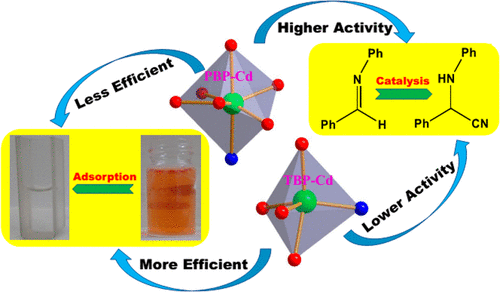当前位置:
X-MOL 学术
›
Inorg. Chem.
›
论文详情
Our official English website, www.x-mol.net, welcomes your
feedback! (Note: you will need to create a separate account there.)
Triggering Lewis Acidic Nature through the Variation of Coordination Environment of Cd-Centers in 2D-Coordination Polymers.
Inorganic Chemistry ( IF 4.3 ) Pub Date : 2020-01-09 , DOI: 10.1021/acs.inorgchem.9b02997 Nikhil Kumar 1 , Avijit Kumar Paul 1
Inorganic Chemistry ( IF 4.3 ) Pub Date : 2020-01-09 , DOI: 10.1021/acs.inorgchem.9b02997 Nikhil Kumar 1 , Avijit Kumar Paul 1
Affiliation

|
The rational design and successful synthesis of novel functional metal-organic frameworks relies on careful selection of metals and versatile organic ligands. A newly designed pyrazole-based dicarboxylate ligand, 5-(3,5-dimethyl-1H-pyrazol-1-yl) 1,3-benzenedicarboxylic acid (H2L), was utilized to obtain two new Cd-based coordination polymers I [Cd(L)(H2O)]·H2O and II [Cd(L)] under similar reaction conditions via solvothermal strategy. Single-crystal X-ray data confirmed that compound I exhibits a two-dimensional (2D) skeleton comprising pentagonal bipyramidal Cd-ions and an organic ligand moiety. Compound II has also formed a two-dimensional layer arrangement with the connectivity between trigonal bipyramidal Cd-ions and the organic ligand. Topological analysis revealed that compound I has formed unique 43.63 net topology while compound II has displayed a 44.62 sql net topology with 2D frameworks. The Lewis acidic nature of both I and II containing a Cd2+ metal center has been correlated with the coordination number through dye adsorption-desorption and catalysis studies. The selective adsorption of anionic dye and the extent of adsorption are interrelated with the Cd-ion geometry. For the first time, the role of coordinated water molecule has been analyzed through heterogeneous catalysis reaction (i.e., cyanosilylation) with Cd-based 2D-coordination polymers (CPs). The plausible mechanisms have been proposed to explain the subsequent role of coordination number and environment in CPs.
中文翻译:

通过二维配位聚合物中镉中心配位环境的变化触发路易斯酸性。
新颖的功能性金属-有机骨架的合理设计和成功合成取决于对金属和多功能有机配体的仔细选择。利用新设计的吡唑基二羧酸配体5-(3,5-二甲基-1H-吡唑-1-基)1,3-苯二甲酸(H2L),获得了两种新型的基于镉的配位聚合物I [Cd (L)(H2O)]·H2O和II [Cd(L)]在相似的反应条件下通过溶剂热策略。单晶X射线数据证实了化合物I具有二维(2D)骨架,该骨架包含五边形双锥体的Cd离子和有机配体部分。化合物II还形成了二维层排列,其在三角双锥体Cd离子和有机配体之间具有连通性。拓扑分析表明化合物I已形成独特的43。63网络拓扑,而化合物II显示了带有2D框架的44.62 sql网络拓扑。通过染料吸附-脱附和催化研究,含有Cd2 +金属中心的I和II的路易斯酸性都与配位数相关。阴离子染料的选择性吸附和吸附程度与Cd离子的几何形状有关。首次通过与基于Cd的2D配位聚合物(CP)的多相催化反应(即氰基硅烷化)分析了配位水分子的作用。已经提出了合理的机制来解释协调伙伴中协调编号和环境的后续作用。通过染料吸附-脱附和催化研究,含有Cd2 +金属中心的I和II的路易斯酸性都与配位数相关。阴离子染料的选择性吸附和吸附程度与Cd离子的几何形状有关。首次通过与基于Cd的2D配位聚合物(CP)的多相催化反应(即氰基硅烷化)分析了配位水分子的作用。已经提出了合理的机制来解释协调伙伴中协调编号和环境的后续作用。通过染料吸附-脱附和催化研究,含有Cd2 +金属中心的I和II的路易斯酸性都与配位数相关。阴离子染料的选择性吸附和吸附程度与Cd离子的几何形状有关。首次通过与基于Cd的2D配位聚合物(CP)的多相催化反应(即氰基硅烷化)分析了配位水分子的作用。已经提出了合理的机制来解释协调伙伴中协调编号和环境的后续作用。已通过与基于Cd的2D配位聚合物(CP)进行多相催化反应(即氰基硅烷化)来分析了配位水分子的作用。已经提出了合理的机制来解释协调伙伴中协调编号和环境的后续作用。已通过与基于Cd的2D配位聚合物(CP)进行多相催化反应(即氰基硅烷化)来分析了配位水分子的作用。已经提出了合理的机制来解释协调伙伴中协调编号和环境的后续作用。
更新日期:2020-01-09
中文翻译:

通过二维配位聚合物中镉中心配位环境的变化触发路易斯酸性。
新颖的功能性金属-有机骨架的合理设计和成功合成取决于对金属和多功能有机配体的仔细选择。利用新设计的吡唑基二羧酸配体5-(3,5-二甲基-1H-吡唑-1-基)1,3-苯二甲酸(H2L),获得了两种新型的基于镉的配位聚合物I [Cd (L)(H2O)]·H2O和II [Cd(L)]在相似的反应条件下通过溶剂热策略。单晶X射线数据证实了化合物I具有二维(2D)骨架,该骨架包含五边形双锥体的Cd离子和有机配体部分。化合物II还形成了二维层排列,其在三角双锥体Cd离子和有机配体之间具有连通性。拓扑分析表明化合物I已形成独特的43。63网络拓扑,而化合物II显示了带有2D框架的44.62 sql网络拓扑。通过染料吸附-脱附和催化研究,含有Cd2 +金属中心的I和II的路易斯酸性都与配位数相关。阴离子染料的选择性吸附和吸附程度与Cd离子的几何形状有关。首次通过与基于Cd的2D配位聚合物(CP)的多相催化反应(即氰基硅烷化)分析了配位水分子的作用。已经提出了合理的机制来解释协调伙伴中协调编号和环境的后续作用。通过染料吸附-脱附和催化研究,含有Cd2 +金属中心的I和II的路易斯酸性都与配位数相关。阴离子染料的选择性吸附和吸附程度与Cd离子的几何形状有关。首次通过与基于Cd的2D配位聚合物(CP)的多相催化反应(即氰基硅烷化)分析了配位水分子的作用。已经提出了合理的机制来解释协调伙伴中协调编号和环境的后续作用。通过染料吸附-脱附和催化研究,含有Cd2 +金属中心的I和II的路易斯酸性都与配位数相关。阴离子染料的选择性吸附和吸附程度与Cd离子的几何形状有关。首次通过与基于Cd的2D配位聚合物(CP)的多相催化反应(即氰基硅烷化)分析了配位水分子的作用。已经提出了合理的机制来解释协调伙伴中协调编号和环境的后续作用。已通过与基于Cd的2D配位聚合物(CP)进行多相催化反应(即氰基硅烷化)来分析了配位水分子的作用。已经提出了合理的机制来解释协调伙伴中协调编号和环境的后续作用。已通过与基于Cd的2D配位聚合物(CP)进行多相催化反应(即氰基硅烷化)来分析了配位水分子的作用。已经提出了合理的机制来解释协调伙伴中协调编号和环境的后续作用。











































 京公网安备 11010802027423号
京公网安备 11010802027423号